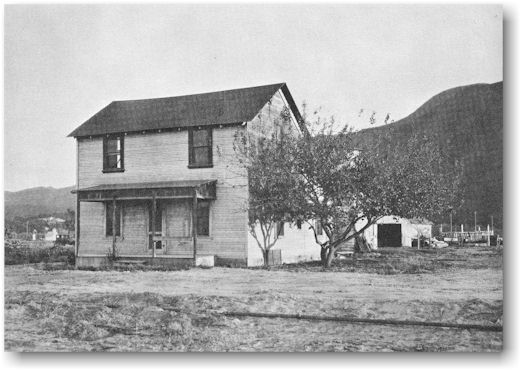Chapter 2 – The American Period
One of the
first Americans to own land in the Rancho San Rafael portion of Burbank was
Jonathan R. Scott. He had come to Southern California from Missouri in 1849.
Scott became the first American justice of the peace in Los Angeles and
administered the oath of office to the first Los Angeles City Council on July
3, 1850.
In 1857, Scott
traded 5,745 acres of land in the La Canada area to Julio and Catalina Verdugo,
heirs of Jose Maria Verdugo, for 4,603 acres on the west side of Rancho San
Rafael. This is the portion of Burbank that, today, contains the main business
district and surrounding area.
In 1862,
Scott planted extensive vineyards on his land. This was the start of the grape
and wine industry in the area. Scott Road was named in his honor.
However, to
David W. Alexander and Alexander Bell goes the honor of being the very first
Americans to own land in any portion of Burbank. These men, who were members of
the first Los Angeles City Council, bought Rancho La Providencia early in 1851
before Jonathan Scott bought the hill area. They paid Vincente de la Ossa 37
1/2 cents an acre for the Mexican land grant of some 4,600 acres. Vincente de la Ossa
wrote:
"The
sum of $1500 which has been paid to my entire satisfaction is the first price
and true value of aforesaid ranch. It is not worth more nor have I found anyone
to give me any more for same."
The two
Americans who purchased Rancho La Providencia and Mr. Scott, who had acquired
the west portion of Rancho San Rafael, did little to develop the land. In 1867,
one person bought both properties, Dr. David Burbank. The picture below clearly shows the two ranchos.

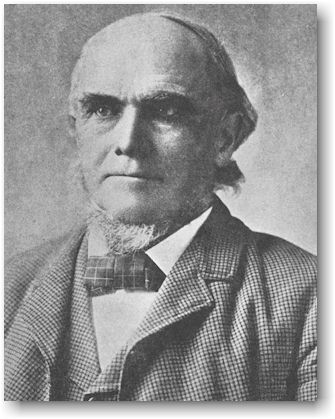
The city of
Burbank takes its name from this man who drove a covered wagon across the
plains while Luther Burbank, the plant wizard, was still a small boy. Dr. David
Burbank, born in 1821 in New Hampshire, was one of California’s most
picturesque pioneers.
In the
middle 1850's, Dr. David Burbank arrived in San Francisco having given up a
fine dental practice in New Hampshire to join the great migration westward and,
by the time the Civil War broke out, he was again well established in his
profession. After the war, he left San Francisco to establish his dental
practice in the "Pueblo de Los Angeles." The booklet, Ranchos de
Los Santos, published in 1927, describes life in the pueblo in the 1860's:
"The
pueblo of Los Angeles was a new experience even for one as accustomed to
frontier life as was Dr. Burbank by this time. No place of the same size in all
the Far West was still so predominantly Spanish. The Castilian and Mexican
tongues were heard more than English on the streets. Adobe houses outnumbered
those built of wood. Saloons with open gambling seemed to outnumber all other
places of business combined. The town was "shot up" with great
regularity. Every weekend furnished its quota of killings. The coroner made a
fortune. There wasn't a foot of paving in town; there were no railroads in all
Southern California and only semi-weekly mail service between Los Angeles and
San Diego, the next largest place. There were no newspapers, the editor of the Star
having moved to San Bernardino hoping for better support. The lone Protestant
Church had great difficulty retaining a minister, so slender was the attendance
and interest. The lone public school house was located at Second and Spring
Streets. A police force and fire department were minus quantities. Street
sprinkling was done personally by the merchants standing in front of their
places of business with a hose. Public conveyances were entirely lacking. There
were no banks or loan offices; there were no men’s or women's clubs, no
temperance or other organizations except a Masonic and an Odd Fellows Lodge.
There was no theatre, no music hall, although small wandering theatrical and
minstrel companies occasionally put in an appearance and gave performances in a
hall. Circuses came annually from Mexico and did a good business....

Dr. David Burbank's ranch house built in 1867. It stood on what is now the back lot of Warner Brothers studio.
"Dr.
Burbank nevertheless found life in the pueblo attractive and interesting,
despite primitive conditions and surroundings. There were no coteries or
cliques. The Mexican, the European, the American, the Jew, the Catholic and the
Protestant all met on terms of social equality. There was a scarce night
without a ball or dancing party being held somewhere in the pueblo. The bon
vivant could obtain many of the good things of life for almost nothing. A
finely fattened turkey hen of ten pounds could be procured for from 50 to 75
cents and chickens from 15 to 20 cents. Porterhouse steaks ranged from 7 to 10
cents a pound. Fish were caught and peddled by Chinamen who cleaned and sold
them at not over 5 cents a pound."
In 1867, Dr.
Burbank bought the 4,603 acres of the historic Rancho San Rafael from Jonathan
Scott and 4,600 acres of Rancho La Providencia from David Alexander and
Alexander Bell for approximately $1 an acre. Although he did not acquire clear
titles to both properties until 1871 after the long court action known
historically as the "Great Partition," Dr. Burbank maintained his two
ranchos as one large ranch. He became one of the largest and most successful
sheep raisers in southern California. He was so successful that he soon stopped
practicing dentistry and invested heavily in real estate in Los Angeles.
Dr. Burbank
sold a right-of-way along San Fernando Road to the Southern Pacific Railroad.
This transaction, on February 28, 1873, cost the railroad $1. The first
train passed through Burbank on
April 5 1874.
Ten years
later the Santa Fe and Southern Pacific Railroads waged a price war. For a short time in 1887, the fare from Kansas
City to Los Angeles was only $1. Many people took advantage of the low fares
and migrated to California. Land prices soared and more than 100 towns were
founded. Burbank was one of these towns.
The first
public school in San Fernando Valley was located where the Van Norman (formerly
San Fernando) Reservoirs now stand. As shown in the picture, children of all
ages were taught by one teacher.

The first
school district in Burbank was established on June 3, 1879, upon petition of
Mr. S. W. White and nine other citizens. It was known as Providencia School
District. The first school building in Burbank was built during that year. It
was located on Burbank Boulevard, close to what is now Mariposa Street. Dr.
David Burbank gave one acre of land for this school. The building was a
one-gable, frame structure made of redwood, and is reported to have cost $400.
At that time, there were nine families in the area who sent children to the
school. As far as can be learned, the school was used until about 1887 when it
was abandoned because the classes moved to a new grammar school on Magnolia
Boulevard and San Fernando Road. The new school was constructed on what was
much later to be a parking lot behind business houses on San Fernando. It faced
on Magnolia Boulevard.
In 1886, Dr.
Burbank sold nearly 9,000 acres of his property for $250,000. This may have
been because a severe drought that year caused a shortage of grass and water
and thousands of Dr. Burbank's sheep died.
The group of
men who bought the acreage formed the Providencia Land, Water and Development
Company with Dr. Burbank as one of the directors. The land was surveyed and a
business district was laid out, surrounded by residential lots. The outlying
area was divided into small farms. The original plot of the townsite of Burbank
extended from what is now Burbank Boulevard on the north, to Grandview Avenue
in Glendale on the south, and from the top ridge of the Verdugo Rills on the
east to what is now Clybourn Avenue on the west. When the town was incorporated
in 1911, its territory was reduced in size because incorporation data left out
a large section of land between Alameda and Grandview Avenues. This land was
county territory until Glendale annexed it just as Burbank was about to add it
to the city.
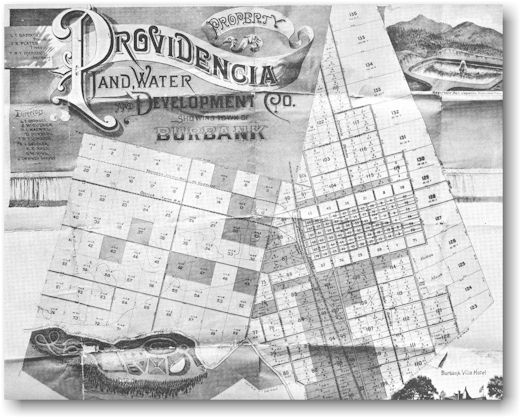
The following
year, 1887, Burbank was founded. It officially became a town on May I when the
lots and farms were offered for sale. An advertisement to lure buyers read:
"Land
and ocean, mountain and valley, sunshine and shade, offer here their choicest
benefactions to prolong the lives of the feeble and enhance the enjoyment of
the robust. In no place are these natural advantages more remarkably manifest
than in the San Fernando Valley, in which are spread the broad acres of
Providencia and on whose sightliest eminence stands the new townsite of
Burbank."
In less than
a year sales amounted to $475,000, "and this without a single free lunch,
brass band, or excursion, and with but little advertising."
Speaking of
the new town in September of that year, the Los Angeles Express said:
"Sheep
pastures and barley fields passing and orchards and vineyards being created
from old ranchos - an example, Providencia, for years famous for the fertility
of its soil. Burbank, the town, being built in the midst of the new farming
community, has been laid out in such a manner as to make it by and by an
unusually pretty town. The streets and avenues are wide and, all have been
handsomely graded. All improvements being made would do credit to a city....
Everything done at Burbank has been done right. There is not a shabby building
in town.”
The
Providencia Land, Water and Development Company laid out wide streets such as
Olive Avenue, and each of the officers of the company built a handsome home
with "city conveniences." A luxurious $30,000 hotel, the Burbank
Villa, was built on the site of the present main post office building.
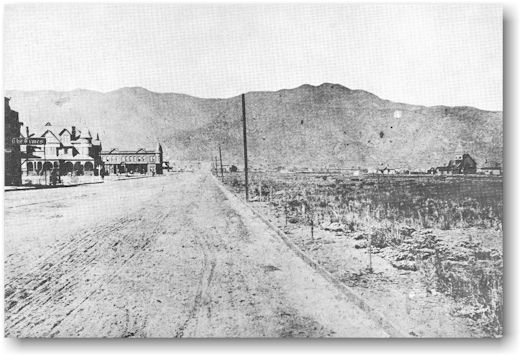
Dr. Burbank
and his son built the Burbank Villa for the land company. Down the street The
Times, a small weekly newspaper, was first published on November 12, 1887. A
subscription cost $10 a year payable in advance in cash. A short distance to
the east, the Providencia Methodist Episcopal Church had been dedicated in
1884, before the founding of Burbank.
Across San
Fernando Road, the first brick building in town was constructed on the
northeast corner of San Fernando Road and Olive Avenue and was planned for a
bank. The picture below shows the building in 1888. For a time, the Burbank
Post Office was located on the ground level. The "city fathers" met
upstairs to conduct community business. A wooden sidewalk ran in front of this
brick building which was known as the "Burbank Block." When the
boardwalk was torn up in 1911, the children skipped school at the ten o'clock
recess to go down to look for money which they had heard was under the
sidewalk. They had to stay after school to make up the time. The building has
been remodeled several times and still stands today. After an earthquake, the
cupola was declared unsafe and was removed.


The
Providencia Company built the first streetcar line in Burbank. A horsecar line
ran up Olive Avenue from the Southern Pacific station to Sunset Canyon. The
horse pulled the car up the hill carrying prospective buyers of property.
Returning to the station, the horse rode on a small platform at the back of the
car while the car coasted down the hill. The picture opposite, looking down
Olive Avenue toward San Fernando Road in 1889, shows the horsecar tracks.
From early
1887 until late 1888 the town of Burbank grew steadily. Many people had bought
small farms or lots, and thirty substantial dwellings were built. The new
grammar school which was constructed on Magnolia Boulevard in 1887 was a
two-story frame building with four classrooms upstairs and four downstairs. It
had a belfry or bell tower which housed the bell that called the boys and girls
of the community to school each morning. The bell was tolled by means of a long
rope, which extended down from the tower, through the building, to within reach
of the principal at a point right near the front door. At the rear of the
school was a windmill and an elevated tank which stored the water pumped from
the ground. The space below the water tank was framed in, and it was here that
many of the boys and girls kept their bicycles. Near the present corner of
Third Street and Palm Avenue there was a lean-to carriage shed in which the
youngsters kept their horses and buggies and their ponies and pony carts while
they were in school.


Children
came to the Burbank Grammar School from as far away as the area of Brand's
Castle in Glendale, Roscoe (now Sun Valley), and the present Warner Brothers
area at the south end of town. The school playground was the space now occupied
by store buildings along the San Fernando Boulevard frontage between Magnolia
Boulevard and Palm Avenue. During some of the time that the Burbank Grammar
School was used, the children maintained a flower garden in the area in front
of the school and a vegetable garden near the shed which was used to house the
horses and buggies. The care of those gardens provided practical experience for
the boys and girls studying agriculture, one of the main occupations of the
area at that time. There were two lunch houses at the rear of the school, one
for boys, and one for girls. Each child brought in his own drinking cup which
hung in the lunch house, and, of course, the children all brought their own
lunches with them each day. Games were played at recess time in the schoolyard.
These included darebase, pomp-pomp-pull-away and hid and seek. To enter school each morning the boys and
girls lined up in separate lines at the front steps and marched into the
building in time with the sound of a drum, beat by a selected pupil. When the
school first opened, there were four teachers and a principal, and the student
body totaled about 200 children. The school had classes for Grades One through
Eight.
When, in
1889, a depression hit the Los Angeles area real estate values tumbled. Many of
the foothill and boulevard lots in Burbank were sold for taxes. One man, C. B.
Fischer, was able to buy three lots at the corner of Kenneth Road and Olive
Avenue for $80 and three lots at Olive Avenue and San Fernando Road for $800.
The Times was no longer published. A furniture factory was abandoned and tramps
slept in the building until it burned down. Four hundred dollars was all the
money needed to buy a five-room house. Most of the men who had promoted the
Providencia Land, Water and Development Company were ruined financially. Few of
them lived to see their dream of a beautiful city come true.
The outlying
area of the Burbank townsite had been divided into 10, 20, 30, and 40 acre
farms. The natural fertility of the land enabled some ranchers to make a living
on the farms during the long dry spell, which followed the land boom collapse
of 1889. In five of the seven dry years, less than ten inches of rain fell each
season. Water conservation was unknown in the area and there were few
reservoirs to store water for irrigation. However, the fine sand loam and the
natural underground wells gave Burbank some of the finest vineyards in the
world. Burbank became famous for its fine wines and large wineries. Pictured
below is Gai's Winery.

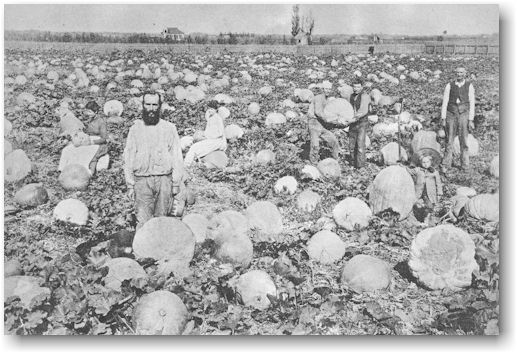
During this
long, dry, depression period other Burbank lands produced crops of peaches,
alfalfa, melons (particularly cantaloupes), pumpkins, and grains. These lands
were located in the Toluca area and were near or actually over the natural
storage basin of the great San Fernando Valley.
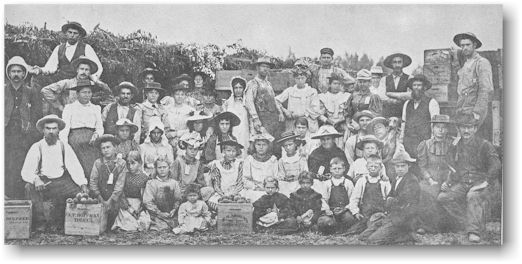
After the
grain was harvested, it was put in large burlap bags. The ranchers loaded the
bags on wagons and transported them to flour mills in Los Angeles. The wagons
traveled through Burbank on San Fernando Road. The flowing three pictures were
taken in the 1890’s.
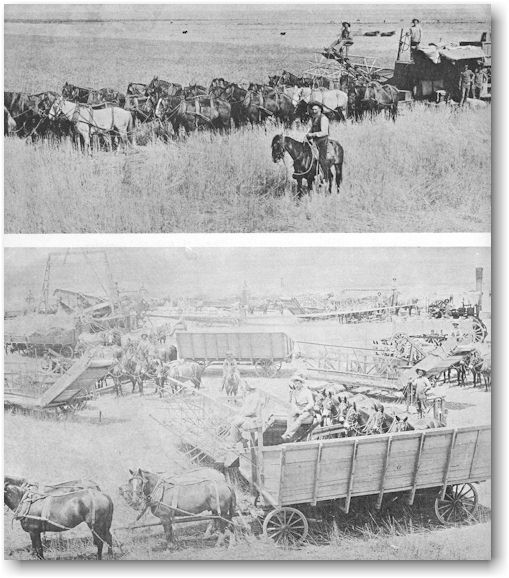

The
remaining undeveloped land around Burbank reverted to the grazing land it had
once been. Flocks of sheep were again seen, and, until 1908, driven along San
Fernando Road on the way to new grazing areas. Store owners closed their doors
and windows while the sheep passed because of the dust.
Jack rabbits
were plentiful in the valley and destroyed many crops. The ranchers would get
together periodically to round up the rabbits in much the same manner as
cowboys round up cattle. After the rabbits were "corralled," they
were shot.
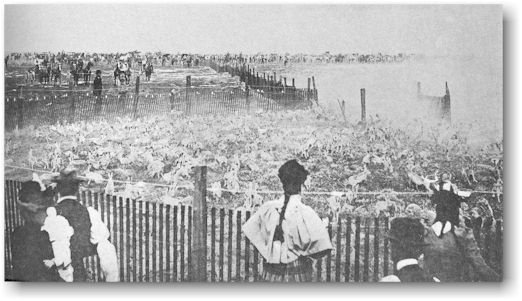
The
following two pictures are representative of the social life of the times. The
groom in this early 1900 wedding picture is Milo Weddington, Sr. Mr. Weddington
helped develop the Lankershim (North Hollywood) area. His son was an officer in
the Burbank branch of Security First National Bank until his retirement in
October, 1965.
Picnics in
the hills above Burbank were popular with the young people. On Sunday
afternoons they used their bicycles to travel to a picnic site under live oak
trees.

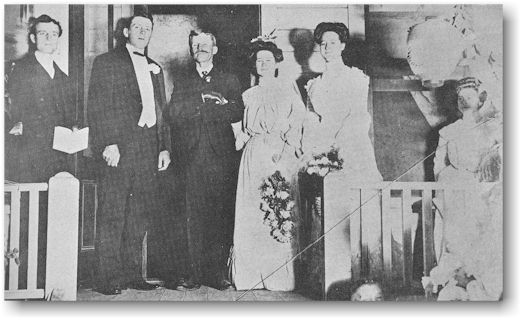
In 1904,
national attention was drawn to Burbank when James J. Jeffries, the heavyweight
boxing champion of the world, bought 107 acres for a ranch on Victory
Boulevard. He paid $2,000 down and assumed a $10,000 mortgage. Only ten acres
were placed under cultivation, and the rest was sagebrush and sand. Jeffries
later developed another 93 acres and planted alfalfa. The market price for
alfalfa dropped shortly after this time and it did not pay Jeffries to harvest
his crop. He decided to put cattle on the land to eat the alfalfa. This proved
to be a prosperous enterprise. Jim Jeffries became one of the country's
foremost suppliers of thoroughbred bulls. Most of them were sold in Mexico and
South America thus establishing Burbank's first foreign trade relations.
Jeffries
built a large ranch home and a barn on the corner of Victory Boulevard and
Buena Vista Street now cross. He gradually sold parts of his ranch until only
his home and barn were left when he died, March 3, 1953. The barn may now be
seen at Knott's Berry Farm where it was moved to make room for the labor union
building now occupying the site. The home deteriorated after Jeffries died and
was torn down several years ago.
The Women's
Christian Temperance Union, an organization which developed to oppose the sale
and consumption of liquor, erected a water fountain at the corner of San
Fernando Road and Olive Avenue. It was a watering trough for horses, cattle,
and other animals. The fountain was near the Burbank Villa. After the collapse
of the land boom, the hotel became a private home. Later, it was reopened as a
hotel with a new name, "Santa Rosa." Mrs. May Clarke owned the
"Santa Rosa" for many years. Mrs. Clarke often acted as an
interpreter for Mexican-Americans living in the area.
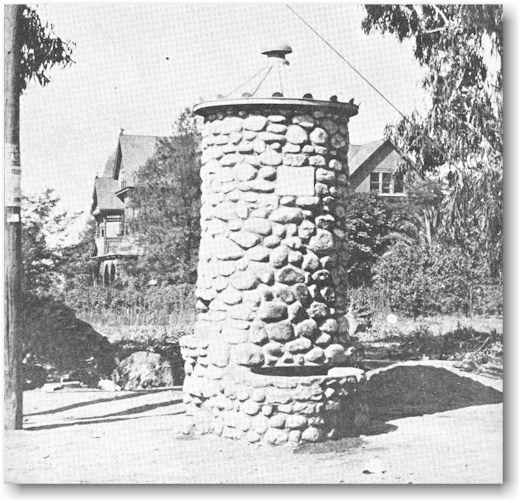
1908 was a
memorable year for Burbank even though the town had failed to qualify for
recognition in the government census of that year because its population was
under 500. One important event was the opening of the first bank, the Burbank
State Bank, near the corner of Olive Avenue and San Fernando Road. H. A. Church
and his son, Ralph O. Church, had purchased a 30-foot frontage on San Fernando
Road for $1,000. Capital stock worth $25,000 was sold and the bank opened on
April 1, 1908. At the end of the first day's business, $30,000 had been
deposited. Ralph Church was the entire personnel. The bank was closed when he
went home for lunch.
The original
bank officers were H. A. Church, President; A. O. Kendall, Vice President; and
Ralph O. Church, Cashier. Additional directors were J. T. Shelton, Orville
Myers, E. A. Knapp, Martin Pupka, and Charles B. Fischer. Two more directors
were added by 1911, Thomas Story and J. H. Avery.
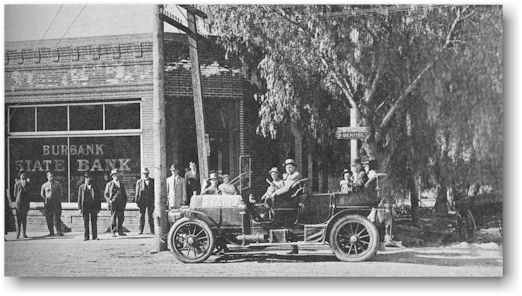
The bank's
deposits rose from $50,000 in 1908 to $146,000 at the end of 1911 and larger
quarters were needed. An additional 20 feet on San Fernando Road and Olive
Avenue were bought for $1,200, the bank building was remodeled, and the floor
space doubled by erecting an addition on the newly acquired frontage. A second
story was then built over all. Other boulevard lots were selling for $250, but
the bank officers thought that the corner frontage was worth the extra money.
In 1911, the Burbank State Bank was dissolved, the First National Bank was
incorporated with a capital of $25,000, and the Burbank Savings Bank was
started with a capital of $25,000. The same management ran both banks under one
roof, the one as a commercial bank, and the other as a savings bank
exclusively. By 1923, Burbank's population had greatly increased from the less
than 500 people in 1908 to over 3,000.

It was
anticipated that Burbank would continue to grow rapidly making a strictly local
bank inadequate to finance such a large number of people. On February 3, 1923,
both banks merged with Security Trust and Savings Bank of Los Angeles, and
became known as the Burbank Security Bank.
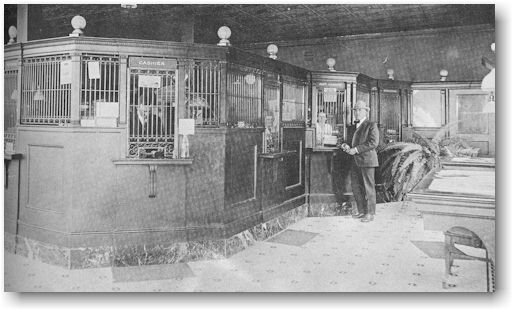

Another
important event that took place in 1908 was the passing of a bond issue to
raise money to build a high school. Burbank high school pupils were attending
school in Glendale. Burbank withdrew from the Glendale Union High School
District after the successful bond issue, and built a high school on San
Fernando Road between Cypress Avenue and Grinnell Drive. While this school was
being built, high school students used three unoccupied rooms in the elementary
school. When the high school started on September 14, 1908, there were 42
pupils and a faculty consisting of a principal and one teacher. Courses were
offered in English, Latin, algebra, geometry, ancient history, physical
geography, and chemistry.

The original Burbank Union High School as it appeared in 1911.
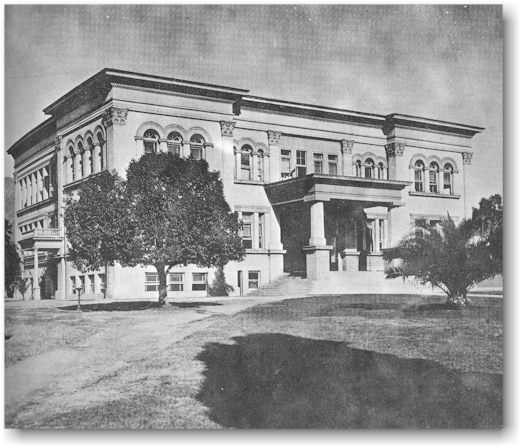
This picture, taken around 1922, shows the building after it had been remodeled and was being used as an intermediate school.
On July 9,
1908, for the first time since 1889, Burbank had its own newspaper. E. M.
McClure published the first copy of the Burbank Review on that date.
It was also
in 1908 that Clementine Lamer, Alphonse Brosseau and Charles B. Fischer bought
a lot on the corner of Orange Grove Avenue and Fifth Street and donated it to
the Los Angeles Diocese. Burbank’s first Catholic Church was built on the lot.
The wooden structure cost $2,000.
The Martin
homestead pictured here was erected on the southwest corner of what is now
Warner Boulevard and Avon Street about 1908, and is typical of the ranch homes
which were built in the Toluca area.
